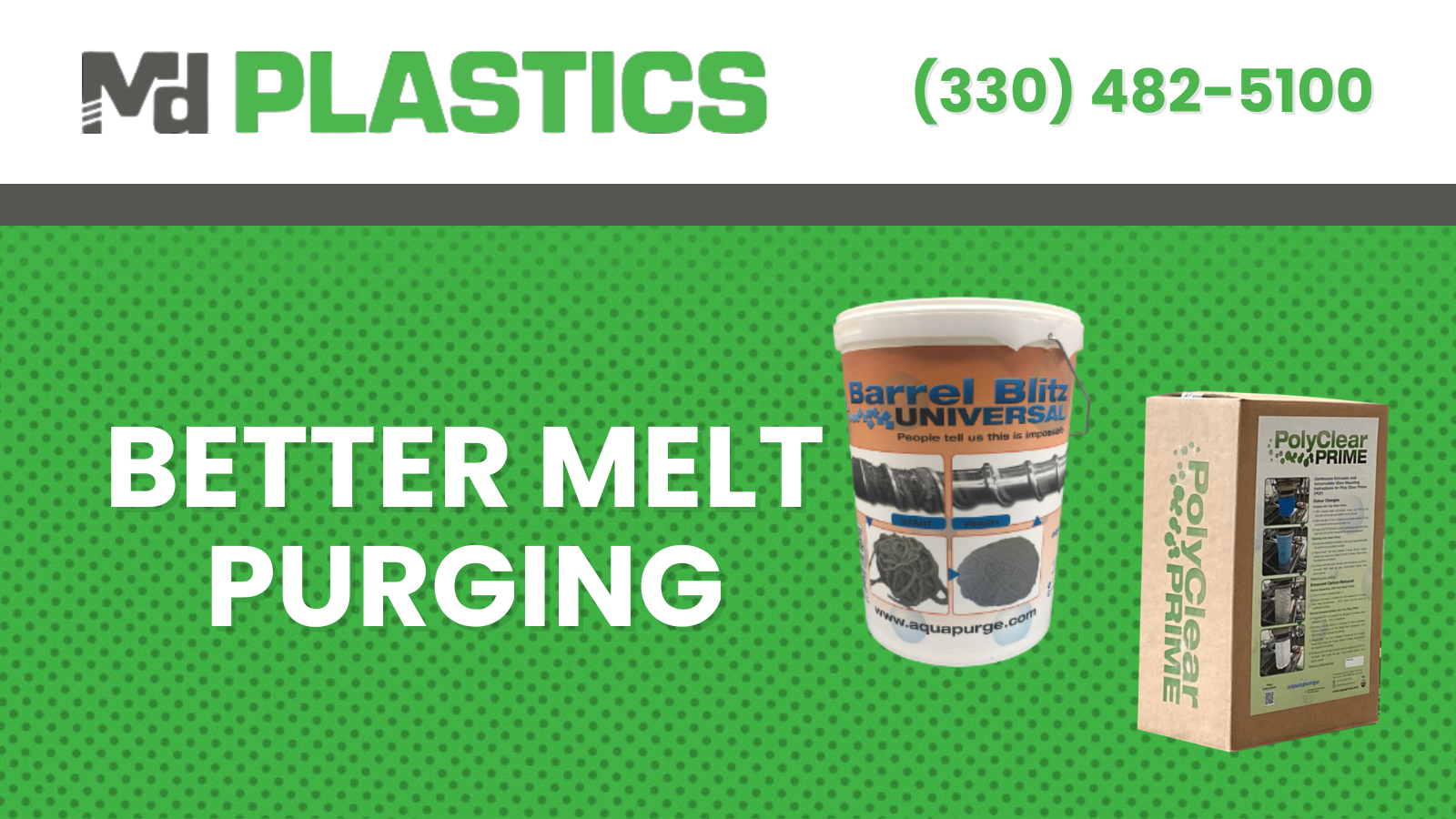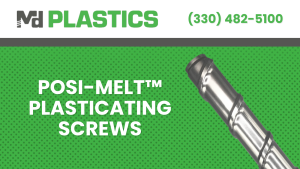For injection molders, maintaining consistency, efficiency, and quality in production relies heavily on the proper care and maintenance of machinery. One of the most critical yet sometimes overlooked aspects of this is performing a proper plasticating system purge. Purging ensures that the machine’s plasticating components remain clean, preventing contamination, degradation, and downtime caused by material buildup or color carryover. But not all purging methods are created equal, and knowing the best way to purge a plasticating system can mean the difference between smooth production and costly interruptions.
At Md Plastics, we have spent decades engineering superior plasticating components and developing technologies designed to optimize melt processing. Understanding the science behind the purging process and how to apply it effectively is essential for any molder committed to improving efficiency and profitability.
Why Purging Is So Important
A plasticating system is the heart of an injection molding machine. It consists of the screw, barrel, non-return valve, and associated components that melt, homogenize, and deliver plastic into the mold. During operation, these components are continuously exposed to high temperatures, pressure, and friction. Over time, residue and degraded material can accumulate on the metal surfaces inside the barrel and screw flights.
If this residue is not properly removed, it can lead to a host of issues, including black specks, streaks, and other forms of contamination in molded parts. It can also cause poor color changes, inconsistent melt flow, and process instability. In severe cases, contamination can even lead to equipment damage or costly downtime for maintenance and cleaning.
Regular purging helps avoid these issues by cleaning out the system before switching materials, colors, or shutting down. It ensures that residual material does not degrade or mix with the next batch, maintaining the integrity and consistency of the product being molded.
The Science Behind a Proper Purge
Purging is not merely a mechanical process; it is a combination of thermal, chemical, and mechanical actions. The goal is to dislodge and remove residual material from the screw, barrel, and non-return valve.
There are generally three approaches to purging:
- Mechanical Purging – using virgin resin or regrind with a higher viscosity to scrape and push out the residual material.
- Chemical Purging – utilizing specially formulated purging compounds that react chemically with residues to break them down for easy removal.
- Hybrid Purging – combining mechanical and chemical principles for an optimized cleaning process.
The effectiveness of a purge depends on several variables, including the resin type, temperature profile, screw design, and the specific contaminants present. A disciplined, systematic approach ensures optimal results and minimizes waste.
When to Purge a Plasticating System
Knowing when to purge is as important as knowing how. Many processors make the mistake of purging reactively, only when contamination becomes visible. However, proactive purging is far more effective and economical.
Common situations when purging should be performed include:
- Material or Color Changes: When switching from one resin or colorant to another, purging ensures no residual material remains that could contaminate the next production run.
- Before Shutdowns: Whether for short breaks or long-term maintenance, purging prevents resin from sitting idle in the barrel, where it can degrade and carbonize.
- After Startups: Purging at startup removes any degraded resin that may have formed while the machine was idle.
- During Process Issues: If black specs, streaks, or inconsistent melt flow appear, purging can restore system cleanliness and process stability.
Regular purging should be integrated into the standard operating procedures of every molding facility.
Common Mistakes Mold Processors Make During Purging
Even experienced molders can make mistakes during purging that reduce its effectiveness or cause unintended damage. Some of the most frequent issues include:
- Using the Wrong Material: Attempting to purge with the same resin or incompatible compounds can result in incomplete cleaning or excessive waste.
- Improper Temperature Settings: Running the purge too hot can degrade the purging compound or the residue, creating more carbon buildup. Running it too cold may prevent proper melting and flow.
- Neglecting Screw Design: Different screw designs require different purging strategies. Ignoring the geometry can leave dead zones uncleaned.
- Insufficient Purge Volume: Stopping the purge too early can leave contamination behind, leading to recurring problems.
- Failing to Inspect and Verify Cleanliness: Purging should always be followed by a verification step, such as visually inspecting the purge discharge or conducting a short run to confirm a clean melt.
Understanding the nuances of your specific plasticating system is key to developing an efficient, reliable purge process.
Choosing the Right Purging Compound
Selecting the proper purging material is one of the most important decisions in the process. While some processors rely on regrind or virgin resin, these materials often lack the necessary cleaning power to remove stubborn contamination.
Dedicated purging compounds are formulated to provide superior cleaning action by combining mechanical and chemical effects. These compounds are designed to:
- Clean residual resin, colorants, and additives from metal surfaces.
- Operate effectively at a wide range of temperatures.
- Minimize downtime during material or color changes.
- Reduce scrap and waste.
- Protect equipment from unnecessary wear.
When evaluating purging compounds, consider the following:
- Compatibility: Ensure the purging compound’s processing temperature is compatible with both the outgoing and incoming materials.
- Residue-Free Performance: The compound should not leave behind its own residue or require excessive purging to remove.
- Ease of Use: Look for compounds that are easy to process and do not require significant parameter adjustments.
- Safety and Environmental Impact: Non-abrasive, non-toxic compounds are better for both operators and equipment longevity.
By investing in a high-quality purging compound, molders can significantly reduce downtime and improve production consistency.
Best Practices for an Effective Purge
To achieve optimal results, follow these general best practices for purging a plasticating system:
1. Prepare the System
Before beginning the purge, remove any materials that may not be compatible with the purging compound. Reduce the feed throat material level and clean out the hopper. Set the barrel temperatures to the appropriate range for the purging compound, usually between the processing temperatures of the outgoing and incoming resins.
2. Begin the Purge Cycle
Introduce the purging compound into the hopper and begin extrusion at a moderate screw speed. Allow the compound to move through the screw and barrel until it displaces all of the previous material. Continue to extrude until the discharge is clean and free of contamination.
3. Use Short, Controlled Screw Strokes
Avoid long, fast screw movements that can cause surging or uneven cleaning. Instead, use short, controlled strokes to maximize shear and contact time between the compound and metal surfaces.
4. Check the Non-Return Valve
The non-return valve is a common site for material buildup. Perform several injection strokes during the purge to ensure complete cleaning of this component.
5. Inspect and Repeat if Necessary
After purging, visually inspect the discharge. If any streaks or color traces remain, repeat the purging process. For particularly stubborn contamination, allow the compound to soak in the barrel for several minutes before resuming extrusion.
6. Transition to the New Material
Once the purge is complete, feed the new resin into the hopper and run the system until all traces of the purge compound are eliminated.
The Role of Screw and Barrel Design in Purging Efficiency
Not all plasticating systems are created equal. The geometry of the screw, barrel, and non-return valve can significantly influence how effectively a system purges.
For example, a general-purpose screw may not generate sufficient shear to dislodge residue in certain resins. Meanwhile, a screw optimized for specific materials or processes can improve mixing and cleaning efficiency.
At Md Plastics, our engineering team specializes in designing precision-engineered screws, barrels, and valves that promote superior melt homogeneity and faster purging. Our patented Melt Profiler™ and Smart Sensor™ technologies provide real-time data on melt conditions, allowing operators to optimize their purging procedures and achieve consistently clean results.
By upgrading your plasticating components with high-performance designs, you can dramatically improve purge efficiency, reduce material waste, and extend component life.
Cost Implications of Poor Purging Practices
Neglecting proper purging procedures can have significant financial consequences. While purging may seem like an additional cost, it is an essential part of preventive maintenance that ultimately saves money.
Some of the hidden costs of inadequate purging include:
- Material Waste: Incomplete purges result in contamination and scrap parts that must be discarded.
- Extended Downtime: Cleaning a severely contaminated system requires disassembly, labor, and lost production time.
- Equipment Wear: Degraded resin and carbonized material can abrade or corrode metal surfaces, shortening component lifespan.
- Reduced Product Quality: Contaminated parts lead to rejections, customer dissatisfaction, and potential loss of business.
By contrast, a disciplined purging routine supported by the right materials and procedures minimizes waste, prevents downtime, and ensures consistent production quality.
How Md Plastics Can Help Optimize Your Purging Process
Since 1999, Md Plastics has been at the forefront of plasticating system innovation. Our expertise extends far beyond purging compounds; we design and manufacture superior plasticating components that deliver measurable improvements in melt quality, consistency, and efficiency.
Our team understands that every molding operation is unique. We analyze your current process, equipment, and materials to develop customized solutions that improve performance and reduce waste. Whether you need help selecting the right purging compound, redesigning your screw and barrel assembly, or diagnosing persistent contamination issues, we bring the technical knowledge, decades of experience, and a disciplined mindset required to deliver results.
Our proprietary technologies, such as the Melt Profiler™ and Rheological Sensor System™, provide molders with unprecedented insight into melt behavior. These tools help identify inefficiencies in the purging and plasticating processes, enabling data-driven improvements that enhance both quality and profitability.
Achieving Long-Term Success with a Disciplined Approach
The best way to purge a plasticating system is through consistency, discipline, and data-driven decision-making. Purging should not be treated as a reactive measure but as a regular part of process maintenance. By establishing standard procedures, selecting the right compounds, and investing in high-quality components, molders can significantly reduce downtime, scrap, and maintenance costs.
Moreover, training operators to understand the importance of purging and how to perform it correctly reinforces a culture of quality and accountability. Every successful injection molding operation shares a common trait: a commitment to precision and continuous improvement.
At Md Plastics, we help molders achieve that by providing the technology, expertise, and support necessary to master every stage of the melt process, from plasticating and purging to molding and maintenance.
Partner with Md Plastics for Proven Purging Solutions
A clean, efficient, and well-maintained plasticating system is the foundation of high-quality molding. The best way to purge a plasticating system is through a systematic approach that combines the right materials, proper techniques, and expertly engineered components. By prioritizing this critical maintenance step, molders can ensure consistent product quality, maximize machine uptime, and protect their investment in equipment.
If you’re ready to take control of your plasticating process and unlock higher efficiency, Md Plastics is here to help. Contact us to learn more about our advanced plasticating components, purging solutions, and industry-leading technologies. Our experienced team will work with you to develop a tailored solution that drives performance and profitability for your molding operation.



